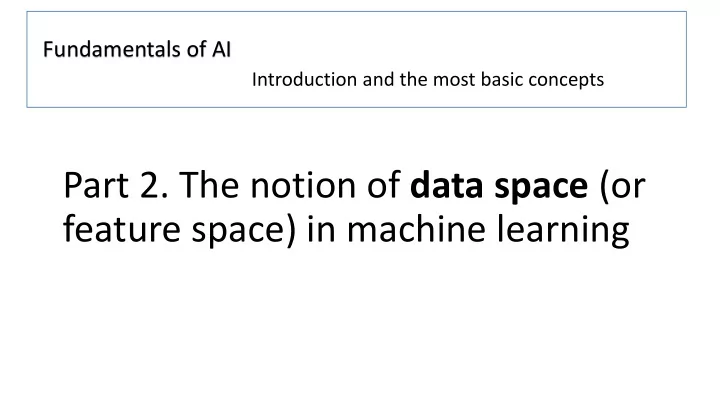

Fundamentals of AI Introduction and the most basic concepts Part 2. The notion of data space (or feature space) in machine learning
What will be DATA for us in this course? Data = Table with numbers + object annotation + variable annotation Variables (features) Objects (samples, measurements)
Geometrical point of view: Analysis of numerical tables = study of a cloud of points in multidimensional space Variables (features) Objects (samples, measurements) R N
Large p, small n Classical statistics n objects Modern ‘machine learning’ p features n objects p variables R n R p BIG DATA: n >> 1 WIDE DATA: p>>n REAL-WORLD BIG DATA: p>>n>>1(most frequently)
Other data types: raw data -> numerical table
Graph embedding Example: recommendation systems
Data types: most of the world data are not numbers! 1) Numerical • Example: weight, height 2) Categorical: • Ordinal Example: age range (infant, toddler, teenager, young, adult, senior) • Nominal Example: eye color, mothertongue Simplest data type: BINARY! (Yes/No, False/True, 0/1)
Data types: Numerical Example: weight, height Must be normalized (made comparable)! Simplest normalization z-score : subtract the mean, divide by standard deviation taking log : by itself make the numbers more comparable The appropriate normalization depends on the initial (raw) distribution (histogram) The final distribution (after normalization) can be a hyperparameter of supervised learning
Data types: Categorical, ordinal Example: age range (infant, toddler, teenager, young, adult, senior) Must be quantified : methods for ordinal variable quantification, univariate and multivariate Simplest univariate: act if the ordinal value is a discretization of a normal distribution Simplest multivariate: maximize the correlation between all quantified ordinal variables, and between all ordinal and numerical variables
Data types: Categorical, nominal Example: eye color Must be converted to numbers Simplest encoding: dummy encoding Eye color Eye color: BLACK Eye color: BLUE Eye color: BROWN Eye color: GREEN BLACK 1 0 0 0 BLUE 0 1 0 0 BROWN 0 0 1 0 GREEN 0 0 0 1 GREEN 0 0 0 1 BROWN 0 0 1 0 BLUE 0 1 0 0 More sophisticated approach: CatPCA
Data types: small conclusion Quantification of data affects all aspects of machine learning and AI, being the most fundamental hyperparameter of any method Quantification of data is tightly related to the definition of distance (next section in this lecture) Quantification of data is a subject of unsupervised learning by itself: normalization of numerical data (learning the target distribution), ordinal (optimal scaling), nominal (CatPCA)
Data point cloud in R N LIDAR Data point cloud
Augmented feature space One can add to the original features, a set of arbitrary functions of them, i.e., all pairwise products If one can guess the right set of basis functions for data augmentation (e.g., polynomial basis of small degree), then the new features can be generated using this basis One of the most popular basis is the basis of radial functions Augmented feature space can be used for learning, and some non-linear problems can become linear in the augmented space Augmenting feature space can be made implicit (without adding new columns in the table), this is the idea of kernel trick
Kernel trick in two words Gramm matrix is the matrix of scalar products Many classical machine learning algorithms can be written down only using the Gramm matrix Kernel trick consists in substituting the Gramm matrix with Kernel matrix, which is a Gramm matrix computed in some augmented feature space (sometimes infinite-dimensional!) and act as it would be the actual Gramm matrix Kernel trick is a powerful way of making classical linear statistical methods (linear regression, principal component analysis) applicable to non-linear data structure
Recommend
More recommend